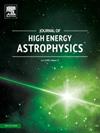Two-component jet model for the afterglow emission of GRB 201216C and GRB 221009A and implications for jet structure of very-high-energy gamma-ray bursts
IF 10.5
4区 物理与天体物理
Q1 ASTRONOMY & ASTROPHYSICS
引用次数: 0
Abstract
In recent years, afterglow emission in the very-high-energy (VHE) band above 100 GeV has been clearly detected for at least five gamma-ray bursts (GRBs 180720B, 190114C, 190829A, 201216C and 221009A). For some of these VHE GRBs, we previously proposed a two-component jet model, consisting of two uniform jets with narrow and wide opening angles to explain their multiwavelength afterglows including VHE gamma rays. In this paper, we show that the VHE spectra and light curves of GRBs 201216C and 221009A can also be reasonably explained by our two-component jet model, based on two top-hat jets propagating into a constant-density circumburst medium. We find that for the five VHE GRBs, the collimation-corrected kinetic energies of the narrow and wide jets have typical values of erg and erg, respectively. We discuss the similarities and differences among the VHE GRBs, and the implications for the structure of their jets. In agreement with previous studies, the narrow jet of GRB 221009A has an atypically small opening angle, so that its intrinsic, collimation-corrected energy remains within a plausible range despite the unusually large isotropic-equivalent energy.
GRB 201216C和GRB 221009A余辉发射的双组分喷流模型及其对高能伽马暴喷流结构的启示
近年来,至少有5次伽玛射线暴(GRBs 180720B、190114C、190829A、201216C和221009A)在100 GeV以上的高能(VHE)波段的余辉发射已经被清楚地探测到。对于其中的一些VHE伽马暴,我们之前提出了一个双组分喷射模型,由两个均匀的窄角和宽角射流组成,以解释它们的多波长余辉,包括VHE伽马射线。在本文中,我们证明GRBs 201216C和221009A的VHE光谱和光曲线也可以用我们的双分量射流模型合理地解释,该模型基于两个顶帽射流传播到恒定密度的环爆介质中。我们发现,对于5个VHE grb,窄喷流和宽喷流的准直校正动能分别具有5×1049 erg和5×1050 erg的典型值。我们讨论了VHE grb之间的异同,以及它们喷流结构的含义。与以往的研究一致,GRB 221009A的窄喷流具有一个非典型的小开口角,因此尽管其各向同性等效能量异常大,但其固有的准直校正能量仍在一个合理的范围内。
本文章由计算机程序翻译,如有差异,请以英文原文为准。
求助全文
约1分钟内获得全文
求助全文
来源期刊

Journal of High Energy Astrophysics
Earth and Planetary Sciences-Space and Planetary Science
CiteScore
9.70
自引率
5.30%
发文量
38
审稿时长
65 days
期刊介绍:
The journal welcomes manuscripts on theoretical models, simulations, and observations of highly energetic astrophysical objects both in our Galaxy and beyond. Among those, black holes at all scales, neutron stars, pulsars and their nebula, binaries, novae and supernovae, their remnants, active galaxies, and clusters are just a few examples. The journal will consider research across the whole electromagnetic spectrum, as well as research using various messengers, such as gravitational waves or neutrinos. Effects of high-energy phenomena on cosmology and star-formation, results from dedicated surveys expanding the knowledge of extreme environments, and astrophysical implications of dark matter are also welcomed topics.
 求助内容:
求助内容: 应助结果提醒方式:
应助结果提醒方式:


